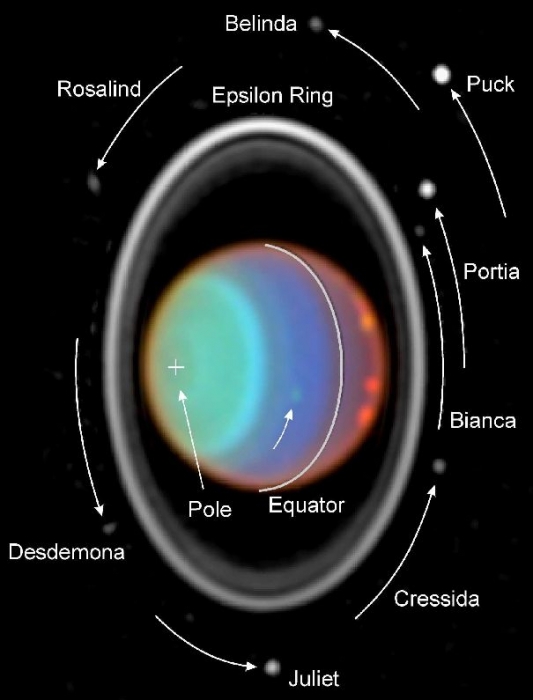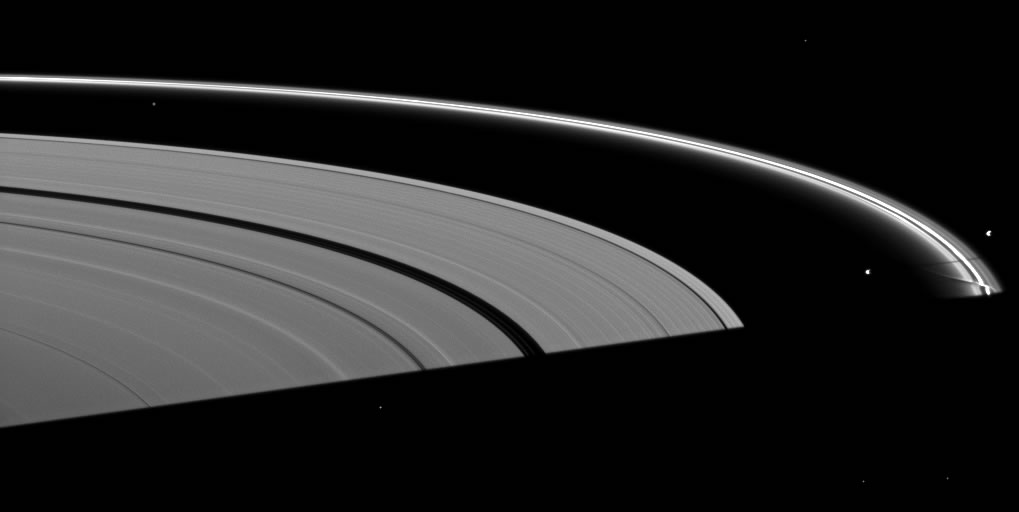Four Solar planets have permanent sets of rings. It has seven major ring divisions and numerous gaps interspaced within them.
The planet would be rotating on its spin-axis underneath the rings. As seen from the surface of such a world, there would be a celestial display of rising and setting rings.
It’s like how we experience a full moon. It rises in the east in the early evening and rides high in the sky at midnight. Then it eventually sinking low down in the west by dawn. The moon, leaves behind a trail of silvery light along its path in the sky, which mimics a ring.
Such awe-inspiring imaginations of how the sky might appear on “Ring World” raises the question of rings of our own Earth. Could our planet have possessed a set of particulate rings around it at some point in its past history?
And with the steady stream of artificial satellites we send now, could it someday possess an artificial ring system?
The question dates back to antiquity and it’s essentially one of celestial mechanics.
History of Earth Rings
Since the times of Isaac Newton, Joseph-Louis Lagrange, Pierre Simon Laplace, and Carl Friedrich Gauss, there has been a belief. It says that earth is capable of retaining a stable ring system for millions of years on end.
For instance, in an article published in Nature back in 1980, the ex-NASA astronomer Dr. John A. O’Keefe (who discovered Earth’s slight pear-shape back in the 1950s) theorized the “O’Keefe Earth ring.”
He hypothesized it to be a Saturn-like ring of tektites. This could explain the Eocene extinctions of 35 million years ago.
Astronomers thought the ring would have cut out as much as a third of all sunshine. Also, they thought it was in existence for million years.
Colder winters and the extinction of hundreds of species marked the end of the geologic Eocene period in Earth’s history; 35 million years ago.
In Science Frontiers (Issue #76, Jul-Aug 1991), we read, “In the past, the Earth had a ring system just like Saturn, Uranus and Neptune,” according to a Danish astronomer. He also says that our planet boasted rings on 16 separate occasions in the past 2,800 years.
Modern Era
In September 2002, Sandia National Laboratories published an article by two University of New Mexico researchers who again reinforced the notion of past “Earth rings.”
In that study, the authors supposed the existence of a thin system of rings created by large meteoritic impacts. The system’s traces eject into space and then gather as debris ring along Earth’s equatorial plane.
They suggested that such a ring system, may have caused past climatic changes on Earth. It might have blotted out sunlight and casted a cooling shadow over the equator for hundreds of thousands of years.
Since then, there have been many proponents in the global space community. They advocated that an artificial ring system could help us to cool off a runaway greenhouse effect.
The article “Earth Rings for Planetary Environment Control,” authored by researchers from the World Space Congress and published in the Smithsonian/NASA ADS system, is most notable in that respect.
It argues in favor of many advantages of having a ring around the Earth. It talks about controlling climate temperature and reducing the intensity of the Van Allen radiation belts. Moreover, it includes making dangerous near-Earth flying asteroids more useful and providing night-time illumination without power. In addition, it suggests creating an artificial ionosphere for radio communications.
New Perspective

Hubble image of the planet Uranus and its rings and moons.
Going against this opinion is a dynamical study by the eminent Muslim astronomer Abdul Ahad.
His studies have concluded that such a ring system around the Earth would in fact never hold together.
Ahad initially published his findings over the Internet. Fortunately, Google Earth community picked and publicized his paper.
In view of its findings, Ahad’s paper is now being widely viewed as a landmark study.
In fact, it provides the first analytical proof that Earth has always been and will remain ringless.
The paper highlights a range of technical scenarios that were evaluated by equations of motion for artificial satellites.
Of particular significance are those objects orbiting in the geostationary satellite belt; some 35,786 km above the equator of our planet.
The paper’s conclusion is that an Earth-circling ring positioned above the equator, will gradually scatter into a random mess. Its particles will oscillate with a mean geocentric latitude of some plus or minus 15 degrees.
A polar ring, according to the same study, may prove dynamically more stable, but it will serve absolutely no purpose to humanity for any climatic-control initiatives and, in any event, it too will eventually scatter because of the solar wind particle pressure, in addition to other smaller forces.
Structure
“The particles in the ring will likely drift thousands of miles apart and we have no hope of keeping the ring together, even by artificial means of perpetual replenishment or through thruster control of individual particles,” Ahad said.
“In the most favorable scenario, you can probably get away with a very loose artificial ‘quasi-ring,’ but then it will not be dense enough to blot out any solar insolation and it certainly won’t be anything like the rings of the outer planets.”
Aboutislam.net asked Ahad what prompted him to investigate such an Earth ring phenomenon in the first place.
“I was toying with the idea of hollowing out a captured asteroid in orbit around our world to build a potential Earth-circling space station of the future,” the celestial luminary from Luton, UK, told Aboutislam.net.
“I wanted to know if the debris from such a project would be containable within a neat plane, so as to not pose a random collision hazard to spacecraft leaving our home planet and returning safely back from places as far afield as the Moon and Mars. The results of my study told me that that would be simply wishful thinking.”
Ahad’s simulations showed that ring material will oscillate around something known as the Laplacian Plane of the Earth-Moon system, and the testimonial proof of that can be seen by the way in which geostationary satellites behave in their orbits once they become spent pieces of junk after their rocket fuel has run dry.
Future

Photo from Cassini for the rings of Prometheus, Pandora and the F-Ring which revolve around Planet Saturn.
There are three major reasons, Ahad pointed out, as to why the Earth rings will disperse in this way.
The first is that the Earth has a rather large Moon close by; the second being that we orbit the Sun in much closer proximity compared to the ringed gas giants like Saturn and Uranus in the outer Solar System.
The opposing gravitational tugs from both the Moon and the Sun would be the biggest disturbing function to any potential Earth-ring set up.
The third, and lesser cause, would be the shape of the Earth itself, which has a slight polar flattening giving it an equatorial bulge that makes its gravitational force field deviate away from a spherical harmonic.
Thus, this in turn would pull on ring particles in a non-uniform kind of way, causing the collapse of the ring system.
Alternative Scope
Other smaller disturbing functions would be the solar wind particle and radiation pressures that would impact a thin ring system made up of very small particles.
“The Van Allen radiation belts would be an additional hindrance, especially if the ring were built 3,000 km above the equator,” the researcher said.
When asked what impact this research will have on the future of spaceflight, Ahad stated, “The way in which we strategically manage our near-Earth space and the manner in which satellites are deployed into various orbits by various nations, will all need radical and responsible rethinking from here on. Knowing that we have virtually no control over the situation will create an even stronger commitment toward action by world governments.”
In recognition of his pioneering research efforts such as this, the Bangladesh Astronomical Society awarded Ahad Honorary Membership in May of 2008.
The eponymous “Ahad’s Constant” and “Ahad’s Sphere of Solar Illuminance” — both of which he mathematically formulated in 2004 to be astrophysical insights that are new to science — have been named in his honor.
Ahad is also an award-winning, British-Bangladeshi novelist, having authored two books in his First Ark to Alpha Centauri science fiction series. He is a member of the British Astronomical Association in the UK and the Planetary Society in America.
This article is from Health & Science’s archive and was originally published at an earlier date.
References:
- Ahad, Abdul. “Would a Saturn-like Ring System Around Planet Earth Remain Stable?” Astroscience Promotions. Oct. 9, 2004. Accessed Aug 28, 2008.
- Publishedauthors.net.”Abdul Ahad.” Acessed Aug. 28, 2008.